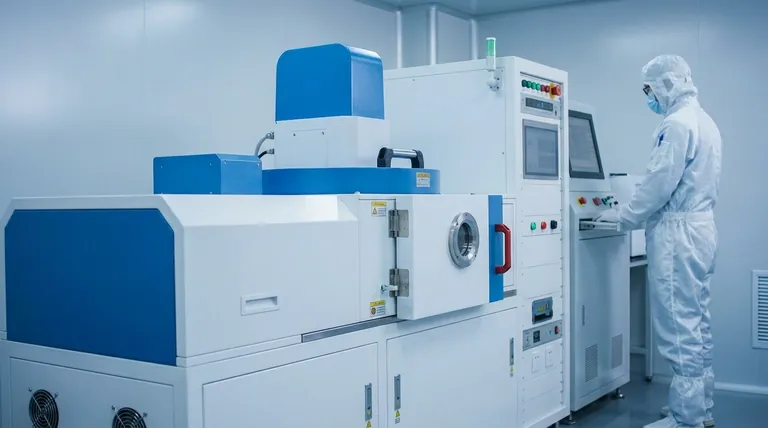No, PVD is not the same as sputtering. Sputtering is a specific and widely used technique that falls under the broader category of Physical Vapor Deposition (PVD). PVD is the overarching name for a family of processes used to deposit thin films in a vacuum, and sputtering is one of the primary methods used to achieve this.
Think of Physical Vapor Deposition (PVD) as the overall strategy for creating a thin film without chemical reactions. Sputtering is one of the primary tactics used to execute that strategy, involving a physical process of atomic bombardment to generate the vapor source.

Deconstructing Physical Vapor Deposition (PVD)
The Core Principle of PVD
Physical Vapor Deposition refers to any process where a solid material is converted into a vapor within a vacuum and then condensed onto a substrate to form a thin film.
The key term is "physical." The material moves from a source to a substrate through physical means—like momentum transfer or evaporation—without undergoing a fundamental chemical reaction.
The Two Main Pathways of PVD
While there are many variations, PVD processes are primarily categorized into two main groups based on how the material is vaporized. Sputtering is one of these groups.
The other major PVD method is thermal evaporation, which uses high heat to melt and then boil a material, causing it to vaporize and travel to the substrate. Understanding this distinction is key to seeing why PVD and sputtering are not interchangeable.
How Sputtering Works as a PVD Process
The Mechanism of Atomic Bombardment
Sputtering is a non-thermal vaporization process. Instead of heat, it uses kinetic energy, operating much like a game of atomic-scale billiards.
First, an inert gas like argon is introduced into a vacuum chamber, and a powerful electric field creates a glowing plasma of argon ions.
The source material, known as the target, is given a negative electrical charge. This attracts the positive argon ions from the plasma, causing them to accelerate and collide with the target at high speed.
Ejection and Deposition
This high-energy bombardment physically knocks atoms or molecules off the target's surface. This process is known as sputtering.
These ejected atoms then travel through the vacuum chamber and condense on the surface of the component being coated (the substrate), gradually building up a thin, highly uniform film.
Common Sputtering Variations
The basic sputtering process has been refined into several advanced techniques to control film properties.
Common methods include magnetron sputtering, which uses magnetic fields to increase efficiency, and reactive sputtering, where a reactive gas is introduced to form compound films (like titanium nitride).
Understanding the Trade-offs of Sputtering
Key Advantages
Sputtering is an industry standard because it is exceptionally versatile. It can deposit a vast range of materials, including metals, ceramics, and complex alloys that cannot be easily evaporated.
The process offers excellent film adhesion and density because the sputtered atoms arrive at the substrate with significant kinetic energy, embedding them firmly onto the surface.
Inherent Disadvantages
Sputtering systems are often more complex and costly than their thermal evaporation counterparts.
The process can have a lower deposition rate, especially for dielectric (insulating) materials. It can also generate significant heat, which may be a concern for temperature-sensitive substrates.
Making the Right Choice for Your Goal
When selecting a PVD process, your end goal dictates the best approach.
- If your primary focus is depositing complex alloys or compounds with superior adhesion: Sputtering is almost always the superior choice due to its versatility and the high energy of the deposited atoms.
- If your primary focus is high-speed, high-purity deposition of a simple metal: Thermal evaporation can be a more direct, faster, and sometimes more cost-effective PVD method.
- If your primary focus is balancing performance, material flexibility, and cost for industrial-scale production: Magnetron sputtering is a well-established and highly reliable industry workhorse.
Understanding this distinction empowers you to select not just a process, but the correct physical mechanism for achieving your specific thin-film goals.
Summary Table:
| Feature | Physical Vapor Deposition (PVD) | Sputtering |
|---|---|---|
| Definition | A family of vacuum processes for depositing thin films | A specific PVD technique using atomic bombardment |
| Primary Mechanism | Physical vaporization (e.g., heat, momentum transfer) | Kinetic energy transfer from ion bombardment |
| Common Types | Sputtering, Thermal Evaporation | Magnetron, Reactive Sputtering |
| Best For | General thin-film deposition | Complex alloys, superior adhesion, uniform coatings |
Ready to select the perfect thin-film deposition process for your application?
Whether your project requires the versatility of sputtering or another PVD technique, KINTEK's expertise in lab equipment and consumables ensures you get the right solution for superior results. Our team can help you navigate the complexities of deposition technology to enhance your laboratory's capabilities.
Contact KINTEK today to discuss your specific needs and discover how our specialized equipment can drive your research and production forward.
Visual Guide

Related Products
- RF PECVD System Radio Frequency Plasma-Enhanced Chemical Vapor Deposition RF PECVD
- Evaporation Boat for Organic Matter
- Chemical Vapor Deposition CVD Equipment System Chamber Slide PECVD Tube Furnace with Liquid Gasifier PECVD Machine
- Microwave Plasma Chemical Vapor Deposition MPCVD Machine System Reactor for Lab and Diamond Growth
- Aluminized Ceramic Evaporation Boat for Thin Film Deposition
People Also Ask
- What are the benefits of PECVD? Achieve Superior Low-Temperature Thin Film Deposition
- How does RF power create plasma? Achieve Stable, High-Density Plasma for Your Applications
- What is plasma activated chemical vapour deposition method? A Low-Temperature Solution for Advanced Coatings
- What are the applications of PECVD? Essential for Semiconductors, MEMS, and Solar Cells
- Why does PECVD commonly use RF power input? For Precise Low-Temperature Thin Film Deposition



















